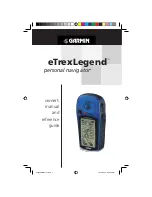
A-2
GG Surveyor GPS+GLONASS Reference Manual
Accuracy
Because GLONASS has no Selective Availability (SA), accuracy of autonomous
(non-differential) GPS+GLONASS positions are 5-10 times better than GPS-only,
and GLONASS autonomous velocity accuracy is more accurate than Differential
GPS velocity accuracy.
Differential Position Accuracy
Because there are more satellites in view, the DOPs (Dilution Of Precision) typically
decrease by 20%-50%, and differential accuracy improves by a similar amount. In
fact, there is no limit to how much the DOPs can change. At times of bad GPS
satellite visibility the GPS DOPs may be tens to hundreds of times worse than the
combined GPS+GLONASS DOPs, at these times the GPS+GLONASS differential
accuracy will be tens to hundreds of times better than GPS differential accuracy.
Also, because SA causes GPS errors to change constantly and rapidly, Differential
GPS corrections must be sent every few seconds. GLONASS errors are natural errors
(such as orbit errors) and these change very slowly, so Differential GLONASS
corrections need to be sent much less frequently than those for DGPS (Figure A.1)
Basic Concepts
GPS and GLONASS both work on the principle of triangulation: if you know your
distance from several known points, then you can compute your position. The known
points for both systems are the satellites. The distance to a satellite is measured by
timing how long the satellite signal takes to reach you; multiply this time by the speed
of light and you have the distance.
The GPS satellite clocks are all synchronized. Similarly, the GLONASS satellites are
all synchronized with each other, but GPS time is not synchronized with GLONASS
time. Thus, the receiver clock has two errors: the error with GPS time, and the error
with GLONASS time. These two clock errors, plus latitude, longitude, and altitude,
give 5 unknowns, which are solved by having 5 satellites (or more) in view.
The GG Surveyor fixes the altitude, if the altitude of the antenna is known; this
removes one unknown, and only four satellites are needed. The GG Surveyor also
determines the offset between GPS and GLONASS time. You can command the
receiver to fix the time offset; this eliminates another unknown, thus only three
satellites are needed for a 2D position, or four for a 3D position. Any combination of
GPS & GLONASS satellites work, the GG Surveyor seamlessly integrates the two
systems into one 48-satellite constellation.
Summary of Contents for GG Surveyor
Page 14: ...xiv GG Surveyor GPS GLONASS Reference Manual...
Page 38: ...20 GG Surveyor GPS GLONASS Reference Manual...
Page 62: ...44 GG Surveyor GPS GLONASS Reference Manual...
Page 86: ...68 GG Surveyor GPS GLONASS Reference Manual...
Page 232: ...B 6 GG Surveyor GPS GLONASS Reference Manual...
Page 236: ...C 4 GG Surveyor GPS GLONASS Reference Manual...
Page 246: ...E 6 GG Surveyor GPS GLONASS Reference Manual...















































